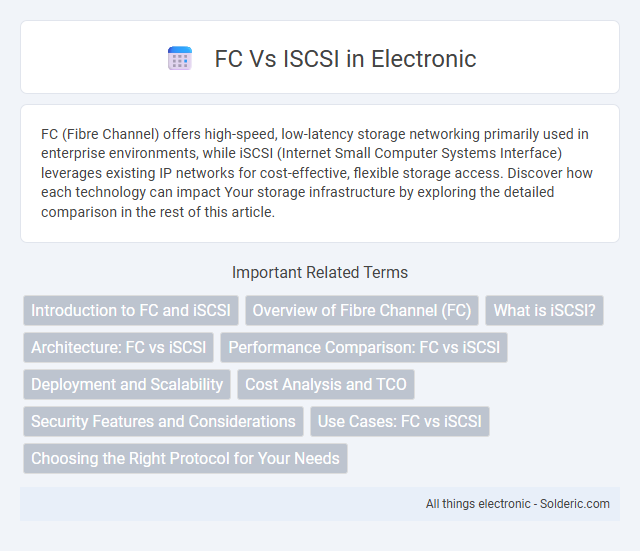FC (Fibre Channel) offers high-speed, low-latency storage networking primarily used in enterprise environments, while iSCSI (Internet Small Computer Systems Interface) leverages existing IP networks for cost-effective, flexible storage access. Discover how each technology can impact Your storage infrastructure by exploring the detailed comparison in the rest of this article.
Comparison Table
| Feature | Fibre Channel (FC) | iSCSI |
|---|---|---|
| Protocol Type | Dedicated Storage Network Protocol | IP-based Storage Network Protocol |
| Transport Medium | Fiber Optic Cable | Ethernet (Copper or Fiber) |
| Speed | 16 Gbps, 32 Gbps, 64 Gbps (FC Standards) | 1 Gbps, 10 Gbps, 25 Gbps, 40 Gbps, 100 Gbps (Ethernet Speeds) |
| Latency | Low latency, optimized for storage | Higher latency compared to FC |
| Cost | High (specialized hardware and switches) | Lower (uses existing Ethernet infrastructure) |
| Complexity | Complex setup and management | Simpler setup with IP networks |
| Scalability | Highly scalable in SAN environments | Scalable but dependent on IP network limits |
| Security | Inherently secure due to dedicated network | Requires additional security measures (e.g. CHAP, IPsec) |
| Use Cases | Enterprise SANs requiring high performance and reliability | Cost-sensitive environments, LAN/WAN storage access |
Introduction to FC and iSCSI
Fibre Channel (FC) is a high-speed network technology primarily designed for storage area networks (SANs), offering low latency and high throughput with dedicated hardware. Internet Small Computer Systems Interface (iSCSI) enables SCSI commands to be sent over IP networks, providing a cost-effective and flexible storage networking solution using standard Ethernet infrastructure. Your choice between FC and iSCSI depends on factors such as budget, performance requirements, and existing network infrastructure.
Overview of Fibre Channel (FC)
Fibre Channel (FC) is a high-speed network technology primarily used to connect data storage to servers in storage area networks (SANs), offering low latency and high throughput with speeds ranging from 8 Gbps to 128 Gbps. FC employs a dedicated fiber optic network infrastructure, ensuring reliable and lossless data transfer ideal for mission-critical applications requiring consistent performance. Its switched fabric topology supports long-distance communication up to 10 kilometers over multimode fiber and up to 100 kilometers with single-mode fiber, making it suitable for enterprise data centers.
What is iSCSI?
iSCSI (Internet Small Computer Systems Interface) is a storage networking standard that enables the transport of SCSI commands over IP networks, allowing for block-level storage access across long distances. It utilizes standard Ethernet infrastructure, making it a cost-effective alternative to Fibre Channel (FC) for connecting servers to storage devices. iSCSI is widely used in enterprise environments for its scalability, ease of deployment, and compatibility with existing network hardware.
Architecture: FC vs iSCSI
Fibre Channel (FC) architecture relies on a dedicated high-speed network composed of switches, directors, and host bus adapters (HBAs) specifically designed for storage traffic, providing low latency and high throughput. In contrast, iSCSI operates over standard Ethernet networks using TCP/IP protocols, enabling storage data transmission through existing LAN or WAN infrastructures without specialized hardware. FC's SAN architecture supports a lossless, dedicated environment optimized for block-level storage, while iSCSI's flexible IP-based architecture facilitates easier integration and scalability in cost-sensitive or mixed network environments.
Performance Comparison: FC vs iSCSI
Fibre Channel (FC) typically outperforms iSCSI in latency and throughput due to its dedicated, high-speed network designed exclusively for storage traffic, achieving speeds up to 128 Gbps. iSCSI leverages standard Ethernet infrastructure, which can introduce variable latency and bandwidth limitations but offers flexibility and cost-effectiveness with speeds commonly up to 100 Gbps on advanced networks. For your performance-critical applications, FC remains the preferred choice where ultra-low latency and consistent high bandwidth are paramount.
Deployment and Scalability
FC (Fibre Channel) offers high-speed, low-latency connectivity with dedicated infrastructure, making deployment more complex and costly but scalable for large enterprise storage environments. iSCSI leverages existing Ethernet networks for easier and more cost-effective deployment, providing flexible scalability suitable for small to medium-sized businesses. Your choice depends on budget constraints, infrastructure readiness, and required scalability.
Cost Analysis and TCO
FC (Fibre Channel) storage solutions often involve higher upfront costs due to expensive hardware, specialized switches, and dedicated cabling, leading to increased initial capital expenditure. iSCSI leverages existing Ethernet networks, significantly reducing infrastructure and maintenance expenses, resulting in a lower total cost of ownership (TCO) for many organizations. When evaluating TCO, iSCSI offers more cost-effective scalability and simplified management compared to the complex and costly ecosystem of FC deployments.
Security Features and Considerations
FC (Fibre Channel) offers robust security features such as built-in zoning to isolate traffic, and LUN masking to control access, ensuring that only authorized devices communicate within the SAN environment. iSCSI relies on network-level security protocols like IPsec and CHAP authentication to protect data transmission over IP networks, which can be more vulnerable to threats compared to the dedicated FC fabric. To maintain your data's integrity and confidentiality, it's essential to implement proper access controls and encryption methods aligned with the specific security challenges of each protocol.
Use Cases: FC vs iSCSI
Fibre Channel (FC) excels in high-performance, low-latency storage area networks (SANs) often deployed in mission-critical enterprise environments requiring high throughput and reliability. iSCSI is well-suited for cost-effective, scalable storage solutions leveraging existing IP networks, making it ideal for small to medium businesses and remote office deployments. Your choice depends on whether your infrastructure prioritizes the speed and robustness of FC or the flexibility and affordability of iSCSI.
Choosing the Right Protocol for Your Needs
When choosing the right protocol for your needs, Fiber Channel (FC) offers high-speed, low-latency performance ideal for large enterprise storage networks, while iSCSI leverages existing Ethernet infrastructure, providing cost-effective and flexible storage solutions. FC is preferred for mission-critical applications requiring maximum throughput and reliability, whereas iSCSI suits small to medium businesses prioritizing scalability and ease of deployment. Your decision should factor in network architecture, budget constraints, and performance requirements to optimize storage area network efficiency.
FC vs iSCSI Infographic

 solderic.com
solderic.com